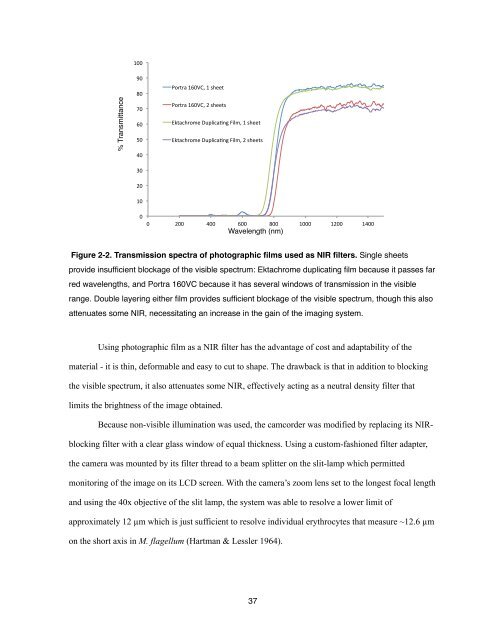Chapter 1, The Reptilian Spectacle - UWSpace - University of ...
Chapter 1, The Reptilian Spectacle - UWSpace - University of ...
Chapter 1, The Reptilian Spectacle - UWSpace - University of ...
Create successful ePaper yourself
Turn your PDF publications into a flip-book with our unique Google optimized e-Paper software.
% Transmittance<br />
#!!"<br />
+!"<br />
*!"<br />
)!"<br />
(!"<br />
'!"<br />
&!"<br />
%!"<br />
$!"<br />
#!"<br />
,-./.0"#(!123"#"4566/"<br />
,-./.0"#(!123"$"4566/4"<br />
78/095.-:6";?90@AB"C?>:3"#"4566/"<br />
78/095.-:6";?90@AB"C?>:3"$"4566/4"<br />
!"<br />
!" $!!" &!!" (!!" *!!" #!!!" #$!!" #&!!"<br />
Wavelength (nm)<br />
Figure 2-2. Transmission spectra <strong>of</strong> photographic films used as NIR filters. Single sheets<br />
provide insufficient blockage <strong>of</strong> the visible spectrum: Ektachrome duplicating film because it passes far<br />
red wavelengths, and Portra 160VC because it has several windows <strong>of</strong> transmission in the visible<br />
range. Double layering either film provides sufficient blockage <strong>of</strong> the visible spectrum, though this also<br />
attenuates some NIR, necessitating an increase in the gain <strong>of</strong> the imaging system.<br />
Using photographic film as a NIR filter has the advantage <strong>of</strong> cost and adaptability <strong>of</strong> the<br />
material - it is thin, deformable and easy to cut to shape. <strong>The</strong> drawback is that in addition to blocking<br />
the visible spectrum, it also attenuates some NIR, effectively acting as a neutral density filter that<br />
limits the brightness <strong>of</strong> the image obtained.<br />
Because non-visible illumination was used, the camcorder was modified by replacing its NIR-<br />
blocking filter with a clear glass window <strong>of</strong> equal thickness. Using a custom-fashioned filter adapter,<br />
the camera was mounted by its filter thread to a beam splitter on the slit-lamp which permitted<br />
monitoring <strong>of</strong> the image on its LCD screen. With the camera’s zoom lens set to the longest focal length<br />
and using the 40x objective <strong>of</strong> the slit lamp, the system was able to resolve a lower limit <strong>of</strong><br />
approximately 12 µm which is just sufficient to resolve individual erythrocytes that measure ~12.6 µm<br />
on the short axis in M. flagellum (Hartman & Lessler 1964).<br />
37
















